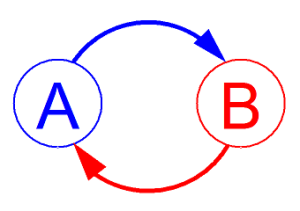For some reason, yesterday seemed to be a day all about feedback loops, where dependent variables impact the independent variables, impacting the dependent variables and so on. I just wanted to write down my thoughts about it quickly, before I forget.
Too many people assume that life is full of simple causal relationships. For example, many people place blame on their external environment if they are in a bad mood. In their minds, the environment directly caused their bad mood. However, even if it initially started out this way, eventually the bad mood of the person will impact their environment. The mood of others will deteriorate as a result of Person A’s bad mood, and their bad mood will cause Person A’s mood to deteriorate further. It is a feedback loop – a vicious cycle that, if you think about it, only the introduction of positive external variables (e.g. caffeine, another happy person, etc.) can halt.
There are countless examples of feedback loops in the real world. Naturally the best examples I can think of have to do with the economy and the political system. I had already been thinking about feedback loops yesterday when an article from The Economist threw another example at me: business lobbying and government intervention. Think about it: more governmental intervention begets more lobbying, which begets more intervention, which begets more lobbying….and so on. In fact, this vicious cycle has become so powerful it has become entrenched, contributing to the rise of an elite class of politicians and crony capitalists. This is a big explanation for widening income inequality: it is caused by a combination of business interests and the government working for one another. The resultant strength of the lobbying industry due to this vicious cycle has also lead to “democratic sclerosis” (coined by Jonathan Rauch), in which it is nearly impossible to eliminate certain rules, loopholes, and programs. Feedback loops have begotten entrenchment.
The business cycle is another example of a feedback loop – in fact, many market forces exhibit feedback loops and thus do not always reflect “rational” behavior. Take an economic expansion. Rising consumer confidence results in higher consumer spending & investment, increasing short term economic growth & creating jobs, which raises consumer confidence more and results in still higher spending & investment, and so on. Eventually, like all bubbles, reality finally sets in – and the feedback loop vicious works in the opposite way. Consumer confidence falls, lowering spending & investment, which drags down economic growth and job creation, resulting in still lower consumer confidence. Whether these boom-bust cycles are healthy or not is a matter of debate – on the positive side, the booms mean that things get done faster than they otherwise would. The downside is that booms can lead to improper investment, meaning the busts can be painful and damaging.
I could go on with more examples, such as the feared health insurance “death spiral”, where young healthy people do not buy insurance, raising premiums and further driving young people away. The basic point has been established, though. Feedback loops are an integral part of our lives, and when intense enough over long durations, can cause entrenched patterns that are near impossible to get out of. They are simply amazing – and terrifying – all at once.

